One of the first artistic techniques in the northern part of Russia is Mezen painting. Its pictures can be seen on household items. The painting gained its greatest popularity in the 19th century. Artistic principles were passed down through the male line of the family.
History of the origin of Mezen painting
The roots of Mezen painting go back to the pagan times of our ancestors. At that time, people believed in gods, their ability to send diseases to people or give crops a harvest. At the same time, man was connected with nature and depended on it. All this was reflected in the patterns of Mezen painting.
The first documented image of Mezen painting dates back to 1815. It got its name from the place where it originated. Characteristic patterns became the hallmark of the village of Palashchelye in the 19th century. The Mezen River flowed near the settlement. It was from this river that the painting began to be called Mezen painting.
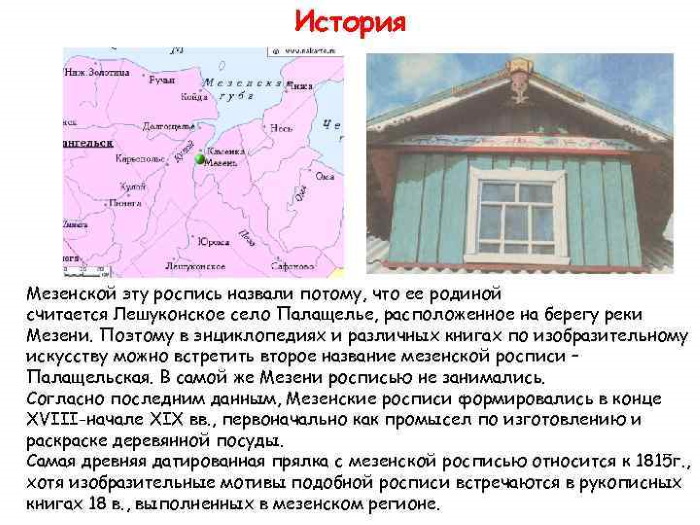
But the area of distribution of artistic craft goes far beyond the boundaries of the village of Palashchelye. Traces of patterns were noticed on objects in the area of the Northern Dvina River, right up to the Onega Peninsula. This graphic technique was also used in the eastern part: in the basins of the Pechora and Izhma Rivers.
Mezen painting (pictures are represented by animals and patterns) belongs to the group of graphic arts. However, it emphasizes the role of brush elements - these are outlines and other lines.
In addition, in this type of painting, such motifs as:
- Running of deer and horses.
- Flight of birds.
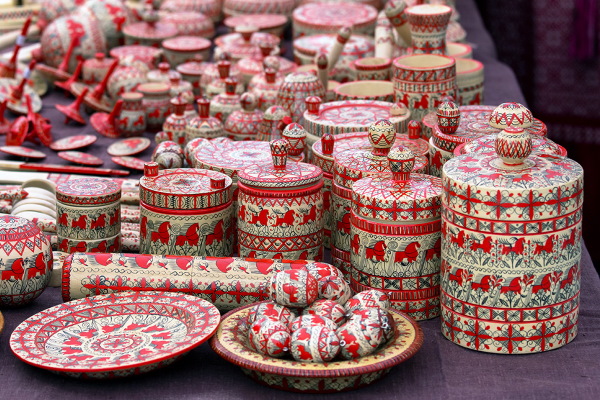
In the past, all artistic paintings had one starting point: Novgorod features. But, in Mezen painting, the traditions of perception of the surrounding world are reflected more vividly. This feature can be explained by the example of the Mezen spinning wheel, because it is the main item of this craft. It was made both for sale at fairs and for home use.
Girls were taught to spin from the age of 6, and therefore the spinning wheel became an integral part of their lives. So, most often, it was this item that was decorated with patterns. If you look at the surviving examples, you can see that the patterns on them are divided into parts - the so-called berds. They resemble a comb, which is a direct reference to the craft of spinning.
Thus, each pattern had a semantic load. They were applied to objects for a reason. An unspoken message was put into the ornament, which for modern people has a pagan, superstitious meaning. In addition, they painted ride-ons, children's cradles.
For painting, the masters used two colours: black and carmine red. Previously, these colors were obtained naturally, without the use of chemically stable compounds. Due to the organic composition of the paint, many painted objects that have survived to the present day have not retained their color. Only the outlines of the sketches remain.

Black color was obtained from soot and resin by combining the two materials together. The first ingredient gave the tone richness, and the second kept it on the surface of the object to be painted. Later, they began to use store-bought ink.
The red color was taken from local clay. The banks of the local Mezen River are rich in this material, and its composition includes iron oxide. Depending on the place where the clay was mined, the pigment was obtained in different shades of red.
Painting began on a clean surface of unprimed wood. For the first stage, ochre or red lead was used. At the end, a wooden stick was crushed into fibers. The black outline was made with a bird's feather, and the painted lines of the pattern were also applied with it.
For this purpose, they most often took fur material from wood grouse or black grouse. To preserve the image, it was covered with natural drying oil. Historians also highlight the korobeyka - a container for storing baked goods, handicraft tools. It, like the spinning wheel, was decorated more often than other household items.
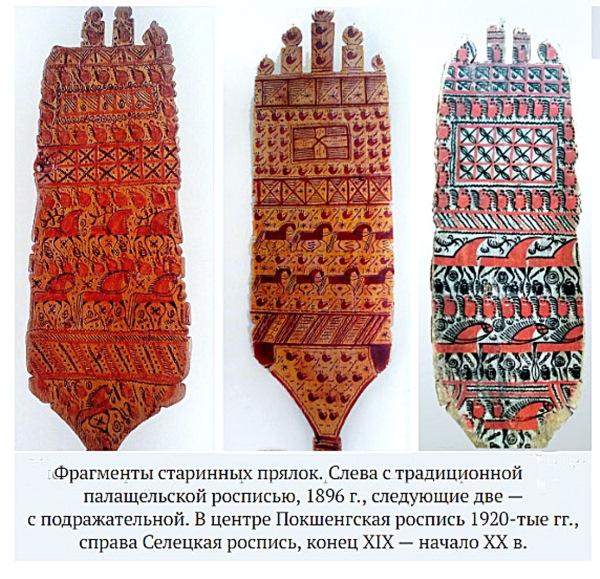
An interesting fact is that it was popular to leave signatures on spinning wheels of that time. They do not look like the initials of a modern person. They are intricate patterns with which families distinguished themselves from others.
Thanks to this, in the 1920s it was possible to restore information about the Palashchel masters who were engaged in this craft. Thus, the names of the Shishovs, Novikovs, Kuzmins, and Aksenovs became known. Interested in this, F.M. Fedotov began the revival of Mezen painting in the mid-1960s.
He uses graphic art technologies in the very heart of Mezen painting – the village of Palashchelye. At the same time, the Fatyanov brothers begin to revive this craft in the village of Selishche. The peculiarity of Mezen painting is that the knowledge and techniques of this art are passed down only through the male line. The father taught his son, and this continued from generation to generation.
Symbolism of the pattern
Mezen painting (pictures and patterns can be seen even on huts) is an archaic type. It reflects the most diverse ideas of the people of that time. Researcher of peasant art Bakushinsky A.V. discovered that the patterns have similar features with the art of the Finno-Ugric tribes.
Mezen painting has a characteristic feature in its pictures: tiers, stripes. Most often there are 3 of them on the pattern.
But the inside of such belts was decorated with images:
- The birds were only in the upper part.
- Horses or deer were drawn in the middle or lower belt.
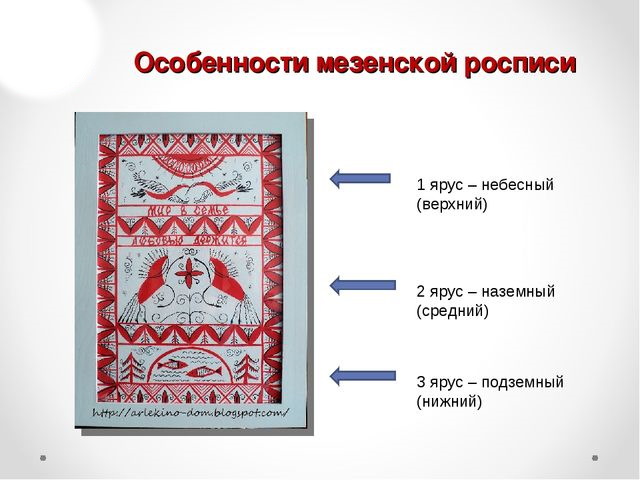
Historians agree that each of the tiers reflects the heavenly, terrestrial and underground division of the world. Spinning wheels were decorated using a special technology: belts were placed on the back side and an inscription could be added. The front side was painted with tiers and symbols.
Mezen painting (its pictures and patterns are usually attributed to pagan and religious foundations) practically does not reflect the life of people, but rather uses images with a subtext. Each symbol of the ornament has a meaningful plot.
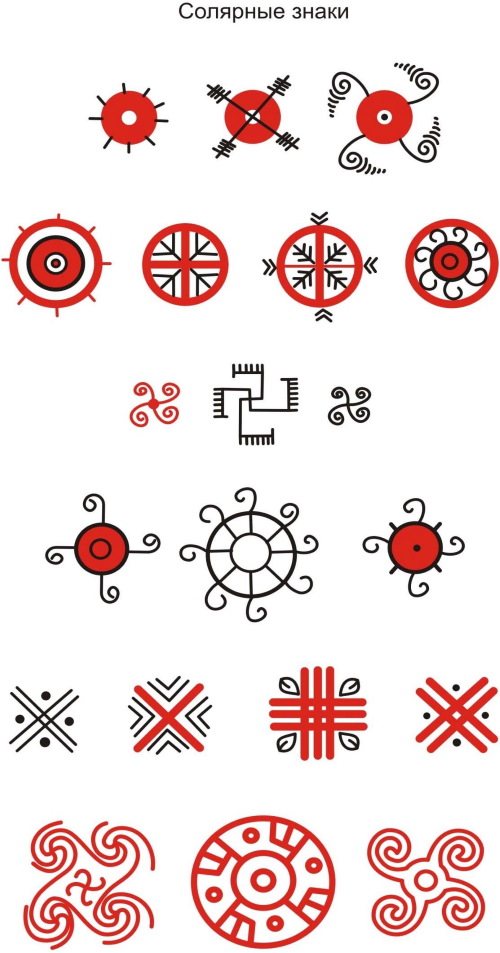
There are so-called solar signs – images of the sun, circles, crosses. They look almost like a swastika. Spoons were usually decorated with a knucklebone. Karabeikas were decorated with only geometric patterns, without characters.
Earth
The earth in Mezen painting symbolizes the mother of all living things, which is the nurse and the basis of existence. Initially it was depicted as a square. A message could be left inside it. For example, a dot meant a fruitful year. The earth was also depicted as a rhombus or triangle.
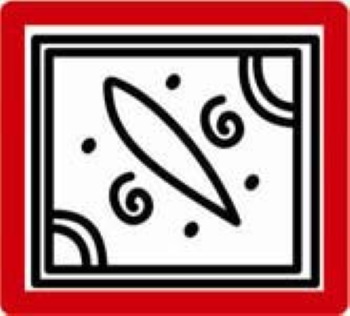
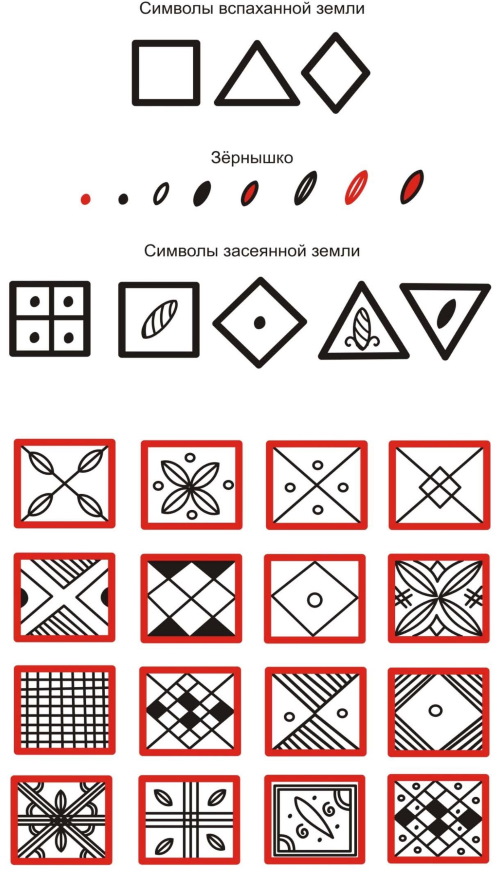
If the area inside the figure was shaded, it meant a sown field. Such a sign was the placement of a seed inside the square. Also, symbols of fertility, spirals, and fire signs were drawn inside the squares.
Water
The symbol denoting water in Mezen painting was depicted as a wavy line or zigzags.

Liquid meant not only a heavenly or earthly element (rivers), but was also a symbol of the birth of a new life. If the earth sign was placed nearby, it meant the birth of something new.
Fire
Mezen painting (pictures with flames could be applied to clothing and house shutters) highlights the symbol of fire as an element that is sometimes life-giving, sometimes destructive. It is depicted in the form of a circle, curls and all elements tending to the circumference.

Fire represents life, energy. It can convey both a creative meaning and one that kills everything around. The importance of fire can be emphasized with double spirals, conical salt signs. In later Mezen painting, fire began to be depicted with crosses or its image in a circle.
Wind (air)
Air currents are depicted as short strokes. Its symbol is an integral ornament of Mezen painting, because it personifies one of the elements of nature. Also, this sign denotes a force that is unpredictable.

The wind is depicted as a violent element, or as a helper of people. Mezen artisans loved to depict tamed air. Therefore, it is often depicted in drawings as a circle, as if strung on straight, crossed lines.
Symbols of Abundance
Symbols of abundance were images of seeds and a ploughed field. They were depicted in shaded squares. Historians agree that such symbols are more of a sign system than a pagan one.
Symbols of abundance were placed in a variety of places: on barns, houses, household utensils. For example, if it was applied to the bottom of spoons, it meant a wish for prosperity and the absence of hunger. When symbols of abundance were painted on the wedding dresses of the bride and groom, it was an unspoken covenant for the young couple to have many children in the future.
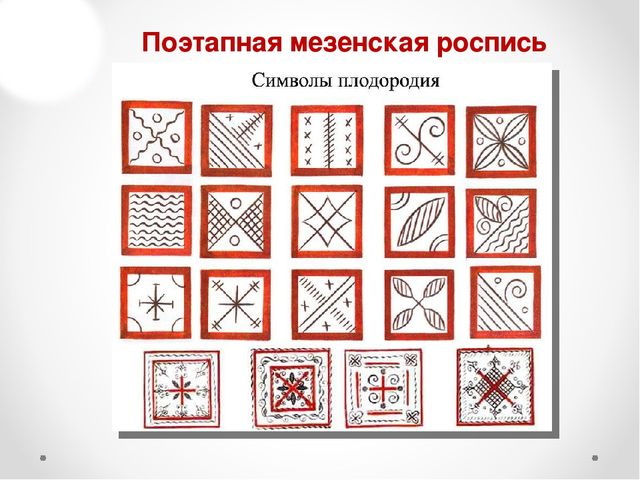
Almost all Mezen patterns are associated with abundance and fertility. Often on objects are depicted plowed land, fruits or flowers - this is also a symbol of prosperity. Such symbols are arranged in a checkerboard pattern or in 2 rows.
The most common abundance pattern is the diamond. It signifies the rebirth of life. The chain of these geometric figures is the personification of the family tree of life.
Patterns in plain and oblique checks
An oblique cross in a square is a sign of the sun and its warmth. If you draw circles next to them, it will mean seeds. Shaded squares meant a sown field. Most often, geometric symbols were used by weavers and embroiderers.
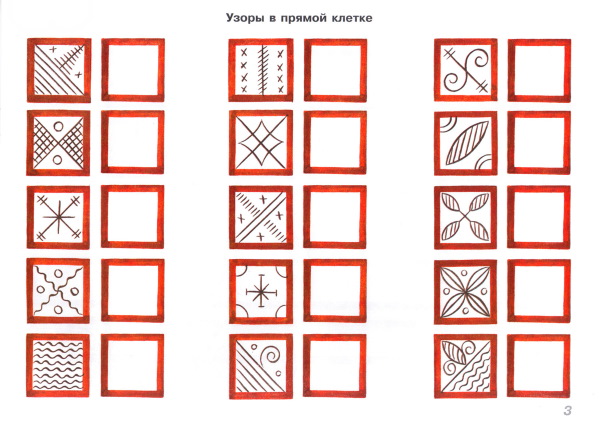
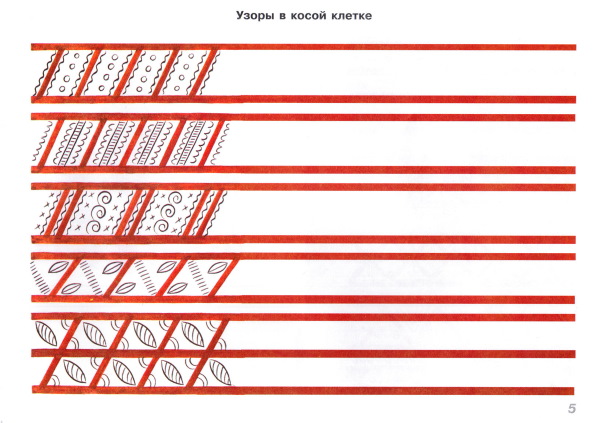
Crosses, diamonds or squares were used as patterns. The symbol of fertility among landowners was a diamond with dots inside.
Ribbon ornament
The ribbon ornament consisted of 3 tiers: earthly, underground and heavenly. They are also called berds. The interior space is filled with different patterns.
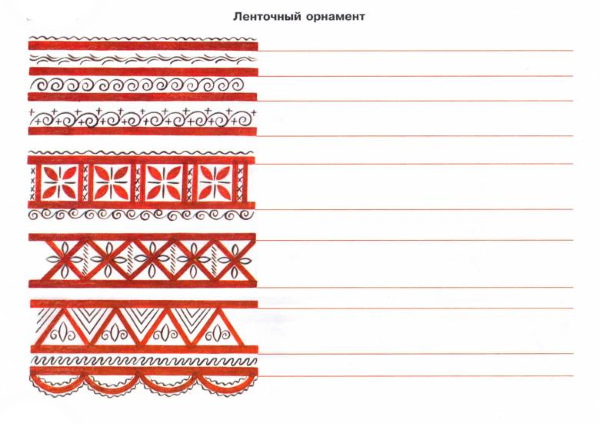
They depend on the location of the ribbon. If it is at the top, it is filled with water symbols. At the bottom, fertility and family patterns are drawn.
Additional painting elements
Flowers, seeds, and fruits in the painting signified fertility and a good harvest.
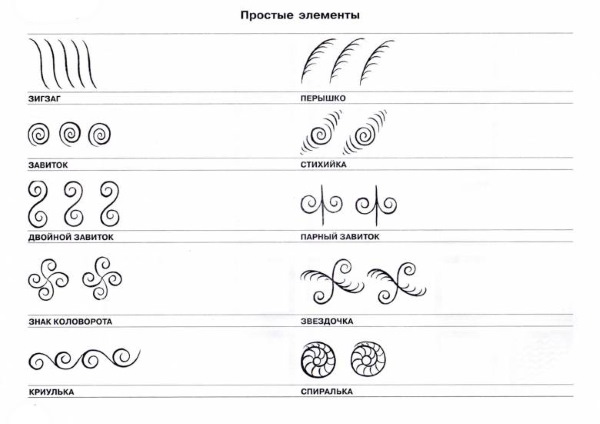
Other elements of the Mezen painting ornament are:
- Double curls.
- Spirals.
- Kryulki.
- Stars.
- Paired curls.
The swastika in Mezen painting is also a calendar sign. For example, the right-handed swastika is the months from December onwards, and the left-handed swastika is the months from June onwards.
Schemes and pictures of decorative images of Mezen painting, instructions for execution
Mezen painting differs from other artistic crafts by the absence of bright and elegant ornamentation. All the patterns look as if they were drawn by a child - the lines do not convey the exact outline of the animals.
However, due to multiple repetitions, a sense of the ornament's dynamism arises. If you look deeper, putting aside the extreme simplicity of the patterns' perception, you can see the integrity of the image, its special sophistication.
Despite the simplicity, the painting qualitatively conveys the characteristic features of deer and horses. They really seem to be in motion. Only 2 colors are used to color the patterns in traditional Mezen painting: black and carmine red.

All patterns are applied to the item without a preliminary template. Even if it turns out uneven, it doesn't matter. It is precisely due to the heterogeneity of the drawings that each of them has its own identity and peculiarity.
First, draw red patterns, let them dry, and then draw black elements. Technique: top-down. The finished drawing is covered with varnish (instead of the previously used drying oil). Beforehand, it is necessary to practice drawing straight lines. This can be done on paper.
To learn beautiful painting, first practice drawing a line without using additional tools. Until this is mastered, it is not worth moving on to complex elements.
| What you need for painting | Drawing technique |
| Palette |
|
| Napkins | |
| Plywood or wood board | |
| Round brushes for painting №1 and 2 | |
| 1 large flat brush | |
| Gouache paints in red and black colors |
Such a picture will combine the most important things in a person's life. His past, connection with ancestors and nature, the cycle of processes throughout the world. All patterns are thought out and do not have a single unnecessary feature.
It is worth considering that when developing a sketch on your own, the lower part of the drawing should be loaded more than the upper one. The earthly area should be more saturated than the heavenly one. It is worth adding everything that is important to a person: family, fertility, symbols of nature.
Birds
Birds symbolize the souls of ancestors. It was believed that they come to help people in difficult times. Feathered ones are like intermediaries between the living and the dead. A duckling was often drawn - a symbol of the sun at sunset. Very often it was depicted in a duet with a horse.

This meant that at night the bird hides the sun in the water, and in the morning the horse takes it to the sky. Often, the flying inhabitants could be replaced by a simple image of a feather.
The image of black grouse and wood grouse reflected the main occupation of the people of that region. They hunted this bird regularly, and it was the main source of income for the natives in difficult times. Large amounts of game were even sent to St. Petersburg.
Animals
Animals in Mezen painting are most often represented by horses and deer. According to pagan concepts, they represent the companions of the gods. In Slavic mythology, horses have a different meaning – they represent the sun. The fact that horses are in motion means the path of the sun across the sky.
Deer are considered a symbol of the gods who give life to everything on earth. Therefore, gifts for women in labor were most often decorated with such patterns. Images of horses have a direct reference to the breed of this animal that lived in those parts. The type of short horses with shaggy legs were called mezenki.
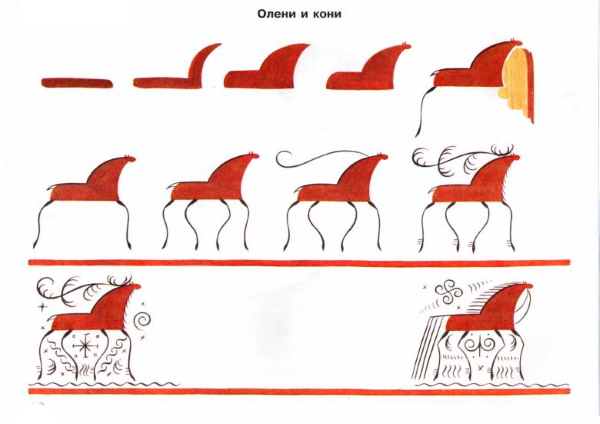
Horses are drawn like this:
- They make a red line - indicating his belly. If there are many horses, then the lines are at an equal distance from each other.
- Draw the horse's chest. To do this, draw a line from above, connecting it to the extreme point of the lower line.
- They make the outline of the horse – thickening the lines in their inner part.
- Draw a muzzle: it can look up or down.
- Horses' legs are painted with black paint. To do this, simply draw curved lines down from the body, imitating the animal's limbs.
- They finish drawing the remaining 3 legs for the horses.
- Using black paint, draw the horse's ear and continue drawing this line along the upper part of the body so that it forms the tail.
- The mane and reins are finished with black paint.
Trees and flowers
The image of a spruce meant male strength or the rich coniferous forests of that region. The family tree was drawn with deep roots - symbolizing the connection with ancestors. The tree trunk was drawn with rhombuses, which are signs of the heritage of ancestors.
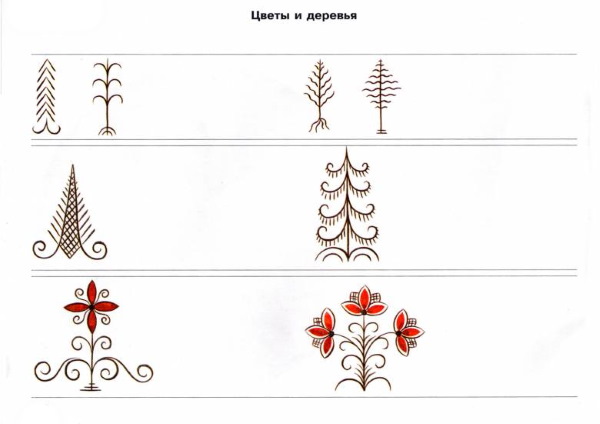
The tree also had a pagan meaning for the people of that time. It was considered a deity that could control rain and the sun. Its mighty crown in the picture indicated a large number of children in the family.
The tree was a symbol of immortality, renewal and showed the image of worldly existence. The roots reflect its past, the trunk – the present, the crown – the future. Its top was often decorated with a solar symbol, characterizing the heavenly world.
The unusual Mezen painting amazes with its deep symbolism. In it, each pattern replaces words, and the pictures created by the ornament tell about the world, nature, and traditions of the people. Sometimes, with the help of the ornament, real canvases were created, reflecting everyday scenes from people's lives.
Video about painting
Mezen painting:
